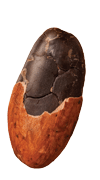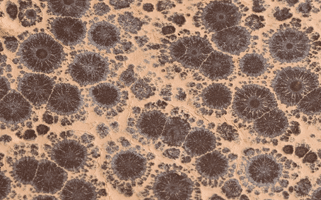
Beans We Drink
Coffee, Cocoa, and the Gut
An enticing cup of freshly brewed java to start the day; a warm, creamy mug of hot chocolate on a cold night – we can’t get enough of these ubiquitous drinks.
- But what are they doing to our bodies?
- Does coffee contain antioxidants that protect against diseases?
- Is hot cocoa beneficial, or just a tasty treat?
- Are these drinks helpful or harmful to our gastrointestinal tracts?
In this article, using evidence gathered during an extensive literature review, we will answer these questions and many more, spilling the beans about these prevalent beverages.
Although we regularly use the terms coffee beans and cocoa beans, neither are actually beans. Coffee beans are the pits/seeds of bright red berries, and cocoa beans are seeds from the cocoa pod. However, we are going with the common vernacular and calling them beans.
Coffee: How it Began
 Aromatic and invigorating, coffee is the most popular drink on the planet, with individuals from most nations and cultures drinking more than 400 billion cups of it per year worldwide.1 The earliest stories of coffee use date back to around 800AD.2,3 Rumour has it that an Ethiopian goat herder named Kaldi was watching his flock one day, when, in amazement, he noticed they seemed to be dancing from shrub to shrub. On closer inspection, he saw they had been nibbling on certain bright red berries, so he decided to try some. After eating the berries, Kaldi felt intense joy and energy, and he began to dance with his goats. Some passing monks saw the commotion and decided to try the berries themselves. Once they realized that these humble berries helped them stay alert and inspired, they began to use them regularly, sending the beans from monastery to monastery, beginning the worldwide spread of coffee.
Aromatic and invigorating, coffee is the most popular drink on the planet, with individuals from most nations and cultures drinking more than 400 billion cups of it per year worldwide.1 The earliest stories of coffee use date back to around 800AD.2,3 Rumour has it that an Ethiopian goat herder named Kaldi was watching his flock one day, when, in amazement, he noticed they seemed to be dancing from shrub to shrub. On closer inspection, he saw they had been nibbling on certain bright red berries, so he decided to try some. After eating the berries, Kaldi felt intense joy and energy, and he began to dance with his goats. Some passing monks saw the commotion and decided to try the berries themselves. Once they realized that these humble berries helped them stay alert and inspired, they began to use them regularly, sending the beans from monastery to monastery, beginning the worldwide spread of coffee.
Around this time, it is also believed that some African tribes were using a mixture made from the flesh of these coffee berries and animal fat to make potent “energy balls” that they could eat for a quick boost.2,4
By about 1000AD, coffee berries had made their way to Arabia, where they eventually received great favour among Muslims, who were the first to roast and brew them.2,3 Coffee gradually spread around the world, mounting into its massive popularity today. Most beans are now grown along the equator in the Bean Belt, between the tropics of Capricorn and Cancer,2 and are sold all over the world.
An Antioxidant-Rich, Disease-Fighting Super-Bean, or a Complete Health Disaster?
While some folks claim coffee is not good for our health, many of us enjoy the social and flavour aspects of the beverage too much to give it up, or we depend on multiple cups to help get through the day, so we drink it devotedly. But is it good for us?
Let’s look at a few studies to see what coffee can – or can’t – do for us.
Is Coffee a Good Source of Antioxidants?
As your body uses oxygen, it produces highly reactive, unstable oxygen atoms that can damage the body (free radicals). Antioxidants are substances that stabilize these free radicals, preventing them from causing damage. If you are a coffee drinker, research shows that your morning pick-me-up may be providing the majority of the antioxidants in your diet.5
Benefits
Studies show that regular coffee consumption, in part due to the antioxidant content, as well as caffeine and possibly other substances, may provide many specific health benefits, including a reduced chance of developing depression,6,7 thyroid disease,8 Parkinson’s disease,9 stroke,10 Alzheimer’s disease and dementia,11 or type 2 diabetes.12 In addition, it can help prevent a number of gastrointestinal disorders, which we will discuss later.
Dangers & Risks
Although coffee may be beneficial in many ways, it does have some downsides. For instance, drinking coffee during early pregnancy may increase the risk of miscarriage.13 Long-term consumption of coffee may also lead to an increase in blood pressure.14 In addition, the caffeine content of coffee can lead to sleep problems, anxiety or jitteriness, and dehydration, so don’t overdo it. If you have any questions or concerns about how the amount of coffee you drink affects your particular health, please discuss this with your physician.
Caffeine Content of Coffee
Brewed: 1 cup (7 oz, 207 mL) = 80-135 mg
Drip: 1 cup (7 oz, 207 mL) = 115-175 mg
Espresso: 1 shot (1.5-2 oz, 45-60 mL) = 75-100 mg
What About Decaf?
The caffeine in regular coffee is a factor both in some positive and negative effects of the beverage. Although decaffeinated coffee is missing the caffeine effects, it still contains the antioxidants, making it beneficial for preventing some diseases, but without the dangers and risks of caffeine. Decaf may also be a safer choice if you suffer from certain GI disorders. However, it is important to know that there are several different processes for decaffeination.
Methylene chloride and ethyl acetate are the solvents currently used to decaffeinate approximately 65% of the world’s coffee. These solvent chemicals extract the caffeine but do not remain on the beans when you buy them; however, they can have an effect on the environment if they are improperly disposed of.
Swiss Water® (www.swisswater.com) is an environmentally friendly chemical-free process, which uses fresh water to decaffeinate the beans. Swiss Water® treated beans are 99.9% caffeine-free, while supporting the great taste of your favourite coffee, so look for the logo on your coffee packaging. Many coffee producers opt for the trusted, trademarked Swiss Water® process.
Coffee Trivia
- Tim Hortons® is Canada’s largest fast food chain; there are more than 3,000 of them across the country, which accounts for 62% of the Canadian coffee market.30
- In spite of popular belief, a study from 201031 shows that adding milk to your coffee does not affect its antioxidant content.
- It is rumoured that cowboys brewed coffee by putting the grounds into a sock, then sticking the sock into a pot of cold water and heating it over a fire.
- Make sure you pronounce espresso as ehss-presso, not ex-presso.
- Do you find coffee a bit too bitter for your taste? Try adding a pinch of salt to the grounds when brewing your cup; it can take the edge off.
How Does Coffee Affect My Gut?
GERD
The evidence for whether coffee is a problem for those suffering from GERD is conflicting. Some studies say that there is no evidence coffee worsens GERD symptoms,15 while others say that it increases heartburn, either by relaxing the lower esophageal sphincter16 or by increasing production of gastrin or gastric acid.17 Since each person is unique, the best way to find out if coffee increases your symptoms is to pay attention to your body. If it bothers you, limit consumption; if it feels good, then enjoy!
IBS & IBD
People who regularly experience diarrhea, such as those suffering from inflammatory bowel disease (Crohn’s disease and ulcerative colitis) or diarrhea-predominant irritable bowel syndrome (IBS-D) may want to avoid excess consumption of coffee. Coffee is a colonic stimulant,18 which makes your stools move through your large intestine faster. This is a problem when you are already suffering from diarrhea. If you have constipation-predominant irritable bowel syndrome (IBS-C), then coffee’s stimulant effects might be helpful.
Colorectal Cancer
In a study where researchers combined the data from several previously published studies (a meta-analysis) and compared coffee consumption to the incidence of colorectal cancer,19 they found no substantial decreased or increased risk of developing colorectal cancer with coffee intake, in most cases. They did find, however, that women who drank four or more cups a day were marginally less likely to develop colorectal cancer than women who rarely or never drank coffee.
Liver Cancer
In another meta-analysis, researchers set out to see if coffee could reduce the incidence of liver cancer. In this case, evidence is promising.20 Researchers found that an increase in consumption of coffee by two cups daily reduced the study participants’ risk of developing liver cancer by 43%, and regular coffee offered more protection than decaf.
Gallstone Disease
Another study followed 46,008 men for 10 years, analyzing their consumption of coffee to see whether the beverage influenced the development of symptomatic gallstone disease.21 It turned out that the men who drank four or more cups of joe per day were the least likely to develop symptomatic gallstone disease, and those who drank no coffee were the most likely. They found the association to be strongest among those who had been consistently drinking regular (not decaf) coffee over time. This finding points to a possible protective effect of coffee on gallstone disease. Researchers aren’t exactly sure why, but they believe it may be related to a few compounds in coffee, including caffeine and a lipid in coffee beans called cafestol.
Summary
There is evidence that coffee can be beneficial to us because of its high antioxidant content and possible disease-preventing powers. However, those individuals suffering from gastrointestinal disorders who find that it worsens symptoms might want to exercise caution when it comes to the amount of coffee they consume.
Cocoa: How it Began
Today, many people enjoy the rich creamy experience of a good hot chocolate and, in doing so, carry on a tradition predating coffee. Archaeologists have found evidence that people have been consuming beverages made from cocoa beans at least since 1900BC, in what is now Mexico. However, those beverages were much different from the ones we drink today; they typically contained spices and were unsweetened.
These drinks eventually became a favourite among the Mayas and the Aztecs. Cocoa first left the Americas when the Spanish explorer Cortez brought it to Spain in the early 16th century, where people started sweetening drinks and foods made with the bean. Eventually, cocoa spread to other parts of Europe, where it remained a treasured treat just for the wealthy until the 18th century, when the price of this imported indulgence finally dropped low enough for less wealthy individuals to enjoy it.22 Today, the industry is huge, producing three million tons of cocoa worldwide each year.23
Can Something So Delicious be Good for Me?
In the modern world, many of us consider chocolate to be bad for our health, even going as far as labelling the stuff as junk food, but research over the past decade shows that cocoa may be beneficial to our health. This doesn’t mean that your average mass-produced candy bar is good for you, but that a piece of dark chocolate or a mug of rich, dark hot cocoa could benefit your health.
Antioxidant Content
Like coffee, cocoa is a good source of antioxidants, containing plenty of flavanols. Research shows that this type of antioxidant may help protect us from cardiovascular diseases.24 A recent meta-analysis with 114,009 participants provides very strong evidence for this. The researchers found that the subjects who consumed the most chocolate had a 37% reduction in cardiovascular disease and a 29% reduction in stroke when compared to those who ate the least amount of chocolate.25
Flavanols vs. Flavonols
Flavanols and flavonols are both flavanoids, a type of antioxidant that is responsible for the bright colours of most plants. Often, you will see the two words used interchangeably. However, they are actually different substances. Flavanols are the antioxidants found in cocoa, as well as wine, tea, berries, grapes, and apples. Flavonols are something different; they are always attached to a sugar molecule, and absorb UV rays, protecting plants from sun damage. Cocoa does not contain flavonols, which are found in a variety of fruits and veggies.26
Chocolate Blooming
 Have you ever opened a bar of chocolate only to find it covered in a strange white substance? This is not a mould as you may expect, but rather crystals of fat or sugar. Fat bloom is the most common, and occurs when manufacturers temper the chocolate incorrectly, or when it’s exposed to too much heat, causing parts of the cocoa butter to melt and seep out to the surface of the candy.
Have you ever opened a bar of chocolate only to find it covered in a strange white substance? This is not a mould as you may expect, but rather crystals of fat or sugar. Fat bloom is the most common, and occurs when manufacturers temper the chocolate incorrectly, or when it’s exposed to too much heat, causing parts of the cocoa butter to melt and seep out to the surface of the candy.
Sugar bloom is less common, and happens when chocolate is stored in a moist or humid environment. The sugar molecules absorb the moisture, and when the moisture evaporates, the sugar dries in larger crystals, leaving a visible white dust. The white coating may look unpleasant and make the chocolate not taste as good as the manufacturer intended, but it is still safe to eat.
How Does Cocoa Affect My Gut?
GERD
An older study27 points to the idea that the ingestion of chocolate may relax the lower esophageal sphincter, which may lead to increased acid reflux in individuals with gastroesophageal reflux disease (GERD). The researchers recommend that individuals with GERD avoid chocolate. However, as with coffee, it is best to test for yourself which foods affect your symptoms.
IBS
When asked what foods most frequently gave them constipation in a survey conducted in 2005,28 individuals with IBS-C, who regularly suffer from constipation, pointed to chocolate as being the number one source of constipation from any specific food. However, it is not clear if the constipation is a result of the cocoa or of the other ingredients commonly found in prepared chocolate.
Prebiotic Effect
Prebiotics are complex carbohydrates that the human digestive tract cannot digest, but good bacteria (probiotics) feed on these substances, increasing populations of probiotics in our guts. A recent study shows that cocoa may be one of these prebiotics. Researchers found increased amounts of beneficial bifidobacterial and lactobacilli strains of bacteria, and decreased amounts of the harmful clostridia bacterial strain in the guts of test subjects who consumed high amounts of cocoa, when compared to those who had much less cocoa.29
Summary
If you suffer from gastroesophageal reflux disease or constipation-predominant irritable bowel syndrome, then cocoa may increase your symptoms. Otherwise, cocoa can help protect your heart health and increase the amount of good bacteria in your gut. Use caution when choosing chocolate products to avoid those high in added fat or sugar, or try enjoying cocoa the way the Aztecs did: with hot chillies (be careful not to use too many!), cinnamon, vanilla, and little to no sugar.


